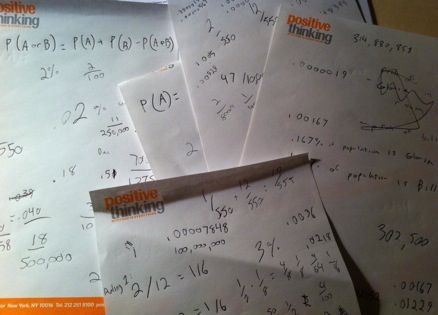“What are the odds of that?” It’s a question we often ask when something that seems incredibly unlikely has happened. As if a number will help us understand better.
Right now we’re working on our February/March issue of Mysterious Ways magazine, and one of the stories is about Gloria and Bill Jamieson, a couple from Jackson, Missouri, who believe they were fated to meet. They cite as evidence many strange coincidences that, when added together, were incredibly unlikely to have happened just by chance. I was asked, for purposes of the article, to calculate the mathematical odds of each coincidence, to give our readers a real sense of how likely or unlikely each twist of fate was.
I was in over my head.
As any math expert can see from my chicken scratch (on old Positive Thinking notepaper), I had no idea what I was doing. In principle, it should have been simple. For example, think about dice. A normal die has six sides, so your chance of rolling a 1 is 1/6. Your chance of rolling a 2 is 1/6, etc. You take the number of outcomes you’re looking for, divide by the number of total possible outcomes, and you have your probability.
Except that the real world isn’t a six-sided die.
Gloria first saw Bill in church, a church with a congregation of 550. She happened to sit in the back pew, right next to where he was standing when someone called his name and caught her attention. What’s the probability that she would sit in that seat and encounter Bill at that moment?
Well, there are 550 people—how many possible combinations of two can we make out of that 550? I used a handy permutations and combinations calculator to help me figure that out. There are 150,975 possible arrangements, only one of which puts Gloria next to Bill. So a 1/150,975 probability.
(I anxiously await the math teacher who says I’m completely wrong about that. Mrs. Treilman from high school? I’m sorry I failed you.)
The worst part was, that was an easy calculation—550 is a small pool. What happens when you’re talking about the population of Jackson, the number of Bills and Glorias in the U.S., the population of the U.S.? The numbers you need to input are huge, and the probabilities that come back are so infinitesimally small.
Knowing the odds doesn’t help—because the numbers get so crazy you can’t wrap your head around them anyway. 1/150,975? That’s .000006623613181 as a decimal. What do you compare that to? As Guideposts Executive Editor Rick Hamlin put it, “I think my head would explode if I tried to figure this out.”
The odds are pretty good that my math is terrible. But the numbers we put into the article aren’t meant to pass peer review. They’re an attempt to quantify a miracle. And I can say with certainty that even the world’s best mathematicians can’t produce a number that explains the most incredible thing about these stories we call “Mysterious Ways.”
They are incredibly unlikely to happen. And yet they do. Every day. To all of us, at one time or another.
Share your story with us. And feel free to correct my math.





